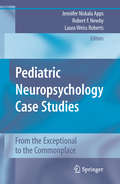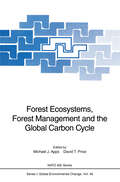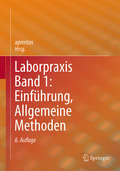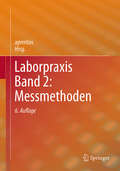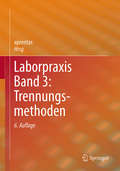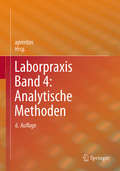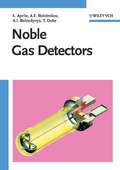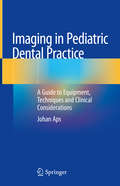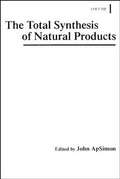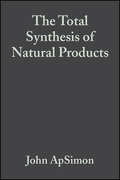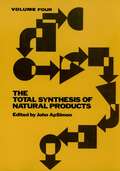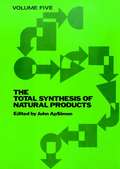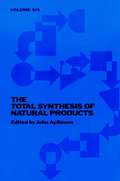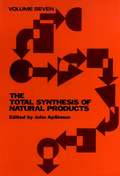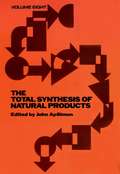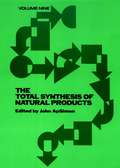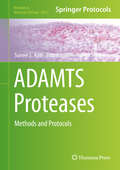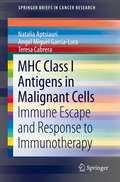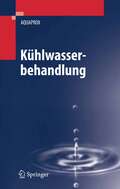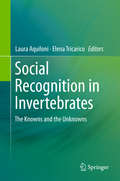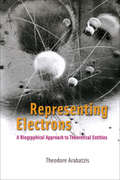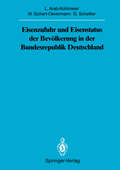- Table View
- List View
Pediatric Neuropsychology Case Studies: From the Exceptional to the Commonplace
by Jennifer Niskala Apps Robert F. Newby Laura Weiss RobertsIn the recent literature, the most influential case study books in neuropsychology are in the adult realm. Pediatric neuropsychology is a rapidly developing field with increasingly greater influence in the assessment, diagnosis, early identification, and treatment of childhood illnesses. This book will provide the first centralized, comprehensive resource for case studies in pediatric neuropsychology. Not only will this supply a valuable compilation for the growing numbers of professionals in this field, but will also serve as an innovative and appealing resource for therapists, teachers, and others interested in child development. This book will be structured in such a way that readers can easily access individual cases of interest, as well as related areas of dysfunction. Section breakdowns will be provided in order to highlight the combined focus of case presentations in acquired neuropsychological dysfunction as well as developmental disorders. Each section will begin with an introductory chapter, highlighting the salient feature of the concept and providing brief, up to date reviews of the current research and theories. Within each global section, individual case studies will serve as stand-alone chapters. Contributing authors will be provided extensive guidance and coaching with regards to the standard format and information to be included in each chapter. The first section of this book will present cases involving neurological disorders. The intention of this section is to provide not only “classic” examples of neurological dysfunction in children, but also to provide interesting cases of unique or remarkable presentations. The second section will present an accumulation of cases representing both common and progressive conceptualizations of developmental disabilities. Section three has been designed to highlight cases which often present complex issues to neuropsychologists. The case examples in this section will highlight the use of alternative treatments, pathologies that are often a source of inquiry, and situations that lack the more rigorous scientific data often utilized in other diagnostic procedures. Additionally, this section may include chapters on common differential diagnosis dilemmas in clinical practice. Often multifaceted and even contradictory evidence can arise during evaluations, resulting in complex or problematic situations for the clinician. Such examples are difficult, by their nature, to forecast, but rather would be added during the book’s development, as they occur.
Forest Ecosystems, Forest Management and the Global Carbon Cycle (Nato ASI Subseries I: #40)
by Michael J. Apps David T. PriceGlobally, forest vegetation and soils are both major stores of terrestrial organic carbon, and major contributors to the annual cycling of carbon between the atmosphere and the biosphere. Forests are also a renewable resource, vital to the everyday existence of millions of people, since they provide food, shelter, fuel, raw materials and many other benefits. The combined effects of an expanding global population and increasing consumption of resources, however, may be seriously endangering both the extent and future sustainability of the world's forests. About thirty chapters cover four main themes: the role of forests in the global carbon cycle; effects of past, present and future changes in forest land use; the role of forest management, products and biomass on carbon cycling, and socio-economic impacts.
Laborpraxis Band 1: Einführung, Allgemeine Methoden
by AprentasDas vierbändige Standardwerk für die grundlegende praktische Arbeit im chemisch-pharmazeutischen Labor mit Schwerpunkt Synthesemethoden, Chromatographie und Spektroskopie liegt jetzt in der 6. völlig neu überarbeiteten Auflage vor. Es dient Berufseinsteigern als breit angelegtes Lehrmittel und erfahrenen Fachkräften als Nachschlagewerk mit übersichtlich dargestellten theoretischen Grundlagen und konkreten, erprobten Anwendungsideen. Die theoretischen Grundlagen für jedes Kapitel sind gut lesbar abgefasst und unterstützen das Verständnis für praktische Arbeiten und Gerätefunktionen. Zu jedem Kapitel gibt es Hinweise auf vertiefende und weiterführende Literatur. Arbeitssicherheit und –hygiene sowie die zwölf Prinzipien der nachhaltigen Chemie finden neben den entsprechenden Kapiteln Beachtung. Die im Buch erwähnten praktischen Grundlagen gründen auf Gegebenheiten in der chemisch-pharmazeutischen Industrie in der Schweiz. Sie finden im gesamten deutschsprachigen Raum Anwendung, auch in verwandten Arbeitsgebieten wie biochemischen, klinischen, werkstoffkundlichen oder universitären Laboratorien. Die Laborpraxis eignet sich für den Einsatz in der Grund- und in der Weiterbildung von Fachpersonal. Der Inhalt entspricht den aktuellen Anforderungen der Bildungsverordnung und des Bildungsplanes zum Beruf Laborantin / Laborant mit eidgenössischem Fähigkeitszeugnis (EFZ), welche vom Staatssekretariat für Bildung, Forschung und Innovation (SBFI) in Bern verordnet wurden. Damit steht den Lernenden eine gute Grundlage für die Vorbereitung auf das Qualifikationsverfahren (QV) zur Verfügung; Expertinnen und Experten stützen ihre persönlichen Vorbereitungsarbeiten und ihre fachlichen Beurteilungen auf dieses Buch. Band 1 und Band 2 behandeln ausführlich die Grundlagen der Laborarbeit und ausgewählte Messtechniken. Band 3 ist auf präparative und analytische Trennungsmethoden, Band 4 auf nasschemische und spektroskopische Analysemethoden fokussiert. Sowohl konventionelle Methoden als auch modernste Techniken finden Erwähnung. Der Fokus auf beständig gültigen Prinzipien erlaubt auch neue, nicht erwähnte Techniktrends zu verstehen sowie die tägliche Arbeit im chemisch-pharmazeutischen Labor zu reflektieren.
Laborpraxis Band 2: Messmethoden
by AprentasDas vierbändige Standardwerk für die grundlegende praktische Arbeit im chemisch-pharmazeutischen Labor mit Schwerpunkt Synthesemethoden, Chromatographie und Spektroskopie liegt jetzt in der 6. völlig neu überarbeiteten Auflage vor. Es dient Berufseinsteigern als breit angelegtes Lehrmittel und erfahrenen Fachkräften als Nachschlagewerk mit übersichtlich dargestellten theoretischen Grundlagen und konkreten, erprobten Anwendungsideen. Die theoretischen Grundlagen für jedes Kapitel sind gut lesbar abgefasst und unterstützen das Verständnis für praktische Arbeiten und Gerätefunktionen. Zu jedem Kapitel gibt es Hinweise auf vertiefende und weiterführende Literatur. Arbeitssicherheit und –hygiene sowie die zwölf Prinzipien der nachhaltigen Chemie finden neben den entsprechenden Kapiteln Beachtung. Die im Buch erwähnten praktischen Grundlagen gründen auf Gegebenheiten in der chemisch-pharmazeutischen Industrie in der Schweiz. Sie finden im gesamten deutschsprachigen Raum Anwendung, auch in verwandten Arbeitsgebieten wie biochemischen, klinischen, werkstoffkundlichen oder universitären Laboratorien. Die Laborpraxis eignet sich für den Einsatz in der Grund- und in der Weiterbildung von Fachpersonal. Der Inhalt entspricht den aktuellen Anforderungen der Bildungsverordnung und des Bildungsplanes zum Beruf Laborantin / Laborant mit eidgenössischem Fähigkeitszeugnis (EFZ), welche vom Staatssekretariat für Bildung, Forschung und Innovation (SBFI) in Bern verordnet wurden. Damit steht den Lernenden eine gute Grundlage für die Vorbereitung auf das Qualifikationsverfahren (QV) zur Verfügung; Expertinnen und Experten stützen ihre persönlichen Vorbereitungsarbeiten und ihre fachlichen Beurteilungen auf dieses Buch. Band 1 und Band 2 behandeln ausführlich die Grundlagen der Laborarbeit und ausgewählte Messtechniken. Band 3 ist auf präparative und analytische Trennungsmethoden, Band 4 auf nasschemische und spektroskopische Analysemethoden fokussiert. Sowohl konventionelle Methoden als auch modernste Techniken finden Erwähnung. Der Fokus auf beständig gültigen Prinzipien erlaubt auch neue, nicht erwähnte Techniktrends zu verstehen sowie die tägliche Arbeit im chemisch-pharmazeutischen Labor zu reflektieren.
Laborpraxis Band 3: Trennungsmethoden
by AprentasDas vierbändige Standardwerk für die grundlegende praktische Arbeit im chemisch-pharmazeutischen Labor mit Schwerpunkt Synthesemethoden, Chromatographie und Spektroskopie liegt jetzt in der 6. völlig neu überarbeiteten Auflage vor. Es dient Berufseinsteigern als breit angelegtes Lehrmittel und erfahrenen Fachkräften als Nachschlagewerk mit übersichtlich dargestellten theoretischen Grundlagen und konkreten, erprobten Anwendungsideen. Die theoretischen Grundlagen für jedes Kapitel sind gut lesbar abgefasst und unterstützen das Verständnis für praktische Arbeiten und Gerätefunktionen. Zu jedem Kapitel gibt es Hinweise auf vertiefende und weiterführende Literatur. Arbeitssicherheit und –hygiene sowie die zwölf Prinzipien der nachhaltigen Chemie finden neben den entsprechenden Kapiteln Beachtung. Die im Buch erwähnten praktischen Grundlagen gründen auf Gegebenheiten in der chemisch-pharmazeutischen Industrie in der Schweiz. Sie finden im gesamten deutschsprachigen Raum Anwendung, auch in verwandten Arbeitsgebieten wie biochemischen, klinischen, werkstoffkundlichen oder universitären Laboratorien.Die Laborpraxis eignet sich für den Einsatz in der Grund- und in der Weiterbildung von Fachpersonal. Der Inhalt entspricht den aktuellen Anforderungen der Bildungsverordnung und des Bildungsplanes zum Beruf Laborantin / Laborant mit eidgenössischem Fähigkeitszeugnis (EFZ), welche vom Staatssekretariat für Bildung, Forschung und Innovation (SBFI) in Bern verordnet wurden. Damit steht den Lernenden eine gute Grundlage für die Vorbereitung auf das Qualifikationsverfahren (QV) zur Verfügung; Expertinnen und Experten stützen ihre persönlichen Vorbereitungsarbeiten und ihre fachlichen Beurteilungen auf dieses Buch. Band 1 und Band 2 behandeln ausführlich die Grundlagen der Laborarbeit und ausgewählte Messtechniken. Band 3 ist auf präparative und analytische Trennungsmethoden, Band 4 auf nasschemische und spektroskopische Analysemethoden fokussiert. Sowohl konventionelle Methoden als auch modernste Techniken finden Erwähnung. Der Fokus auf beständig gültigen Prinzipien erlaubt auch neue, nicht erwähnte Techniktrends zu verstehen sowie die tägliche Arbeit im chemisch-pharmazeutischen Labor zu reflektieren.
Laborpraxis Band 4: Analytische Methoden
by AprentasDas vierbändige Standardwerk für die grundlegende praktische Arbeit im chemisch-pharmazeutischen Labor mit Schwerpunkt Synthesemethoden, Chromatographie und Spektroskopie liegt jetzt in der 6. völlig neu überarbeiteten Auflage vor. Es dient Berufseinsteigern als breit angelegtes Lehrmittel und erfahrenen Fachkräften als Nachschlagewerk mit übersichtlich dargestellten theoretischen Grundlagen und konkreten, erprobten Anwendungsideen. Die theoretischen Grundlagen für jedes Kapitel sind gut lesbar abgefasst und unterstützen das Verständnis für praktische Arbeiten und Gerätefunktionen. Zu jedem Kapitel gibt es Hinweise auf vertiefende und weiterführende Literatur. Arbeitssicherheit und –hygiene sowie die zwölf Prinzipien der nachhaltigen Chemie finden neben den entsprechenden Kapiteln Beachtung. Die im Buch erwähnten praktischen Grundlagen gründen auf Gegebenheiten in der chemisch-pharmazeutischen Industrie in der Schweiz. Sie finden im gesamten deutschsprachigen Raum Anwendung, auch in verwandten Arbeitsgebieten wie biochemischen, klinischen, werkstoffkundlichen oder universitären Laboratorien. Die Laborpraxis eignet sich für den Einsatz in der Grund- und in der Weiterbildung von Fachpersonal. Der Inhalt entspricht den aktuellen Anforderungen der Bildungsverordnung und des Bildungsplanes zum Beruf Laborantin / Laborant mit eidgenössischem Fähigkeitszeugnis (EFZ), welche vom Staatssekretariat für Bildung, Forschung und Innovation (SBFI) in Bern verordnet wurden. Damit steht den Lernenden eine gute Grundlage für die Vorbereitung auf das Qualifikationsverfahren (QV) zur Verfügung; Expertinnen und Experten stützen ihre persönlichen Vorbereitungsarbeiten und ihre fachlichen Beurteilungen auf dieses Buch. Band 1 und Band 2 behandeln ausführlich die Grundlagen der Laborarbeit und ausgewählte Messtechniken. Band 3 ist auf präparative und analytische Trennungsmethoden, Band 4 auf nasschemische und spektroskopische Analysemethoden fokussiert. Sowohl konventionelle Methoden als auch modernste Techniken finden Erwähnung. Der Fokus auf beständig gültigen Prinzipien erlaubt auch neue, nicht erwähnte Techniktrends zu verstehen sowie die tägliche Arbeit im chemisch-pharmazeutischen Labor zu reflektieren.
Noble Gas Detectors
by Elena Aprile Aleksey E. Bolotnikov Alexander I. Bolozdynya Tadayoshi DokeThis book discusses the physical properties of noble fluids, operational principles of detectors based on these media, and the best technical solutions to the design of these detectors. Essential attention is given to detector technology: purification methods and monitoring of purity, information readout methods, electronics, detection of hard ultra-violet light emission, selection of materials, cryogenics etc. The book is mostly addressed to physicists and graduate students involved in the preparation of fundamental next generation experiments, nuclear engineers developing instrumentation for national nuclear security and for monitoring nuclear materials.
Imaging in Pediatric Dental Practice: A Guide to Equipment, Techniques and Clinical Considerations
by Johan ApsThis book is a comprehensive guide to dentomaxillofacial imaging in paediatric dentistry and is an excellent resource for both general dental practitioners and paediatric dentists. Radiation protection, radiation doses and potential risks of ionising radiation are discussed, to provide dentists with appropriate information when they are asked about these important issues in their practice. Technical information about X-ray machines, ranging from the intraoral machine to the medical computed tomography machine, as well as the differences between digital image detectors, are explained to the extend a (pediatric) dentist should know. The latter is important to understand why certain exposure settings are used and what the advantages or disadvantages are of the machines and the image detectors. Non-ionising radiation techniques, magnetic resonance imaging and ultrasonography, are also explained, as well are their applications in the field of dentomaxillofacial radiology. Knowing which imaging technique will provide the best diagnostic images possible, is key to every clinical case a dentist is faced with. A wide range of clinical examples are displayed in this book, ranging from incidental findings to malignant pathology. All are illustrated with radiographic material and explained, in order to give the reader a good sense of what to look for when assessing radiographs in the dentomaxillofacial field
The Total Synthesis of Natural Products (Total Synthesis of Natural Products #1)
by John ApSimonEach volume reviews the total synthesis of a set of compounds looking at syntheses reported historically and at the practice current at the time of publication. From volume 1 focusing on carbohydrates, prostagladins, nucleic acids, antibiotics, naturally occurring oxygen ring compounds and pyrrole pigments, the series continues with coverage of aromatic steroids, monoterpenes, triterpenes, sesquiterpenes, cannabinoids, natural inophores, insect pheromones and alkaloids. Volumes revisit the total synthesis of key compounds such as carbohydrates, nucleic acids and pyrrole pigments several times during the series building a picture of the historic development of total synthesis techniques for these major groups. Chapters are edited by experts in their field to give a complete overview of the best in the field at the time.
The Total Synthesis of Natural Products (Total Synthesis of Natural Products #2)
by John ApSimonEach volume reviews the total synthesis of a set of compounds looking at syntheses reported historically and at the practice current at the time of publication. From volume 1 focusing on carbohydrates, prostagladins, nucleic acids, antibiotics, naturally occurring oxygen ring compounds and pyrrole pigments, the series continues with coverage of aromatic steroids, monoterpenes, triterpenes, sesquiterpenes, cannabinoids, natural inophores, insect pheromones and alkaloids. Volumes revisit the total synthesis of key compounds such as carbohydrates, nucleic acids and pyrrole pigments several times during the series building a picture of the historic development of total synthesis techniques for these major groups. Chapters are edited by experts in their field to give a complete overview of the best in the field at the time.
The Total Synthesis of Natural Products (Total Synthesis of Natural Products #3)
by John ApSimonEach volume reviews the total synthesis of a set of compounds looking at syntheses reported historically and at the practice current at the time of publication. From volume 1 focusing on carbohydrates, prostagladins, nucleic acids, antibiotics, naturally occurring oxygen ring compounds and pyrrole pigments, the series continues with coverage of aromatic steroids, monoterpenes, triterpenes, sesquiterpenes, cannabinoids, natural inophores, insect pheromones and alkaloids. Volumes revisit the total synthesis of key compounds such as carbohydrates, nucleic acids and pyrrole pigments several times during the series building a picture of the historic development of total synthesis techniques for these major groups. Chapters are edited by experts in their field to give a complete overview of the best in the field at the time.
The Total Synthesis of Natural Products (Total Synthesis of Natural Products #4)
by John ApSimonThe Vocabulary of Organic Chemistry Milton Orchin, Fred Kaplan,Roger S. Macomber, R. Marshall Wilson & Hans W. ZimmerIdentifies those terms and concepts which now constitute thevocabulary of organic chemists, then defines and explains theseterms and concepts, most often using examples. Organized so thatsubject matter builds successively on increasingly varied andcomplex material. All terms and concepts related to a particulararea are placed together, except for one chapter on name and typereactions, which is alphabetically arranged. The only book of itskind--valuable to students, teachers and chemical professionalsalike. 1980 Protective Groups in Organic Synthesis Theodora W.Greene Provides essential information on transformations of organicmolecules, including instructions and references for the protectionand regeneration of the major organic functional groups: -OH, -NH,-SH, -COOH, and C = O. Covers the best methods of formation andcleavage, properties of protective groups, selection of a group fora particular need. Organization is by functional groups to beprotected, with groups arranged in order of increasing complexityof structure, and with most efficient methods of formation orcleavage described first. Charts show the reactivities of 270 ofthe most commonly used protective groups to 108 reagents, selectedas prototypes for the entire array of reagents available to theorganic chemist. 1981 Basics of Electroorganic Synthesis DemetriosK. Kyriacou A veteran organic electrochemist illuminatesfundamental ideas and principles by means of selected examples fromthe literature and his own research, demonstrating the practicalunity of the field in a clear, concise manner. Describes thegeneral electroorganic reaction and illustrates the general mode ofconcepts and applications in the area of electrosynthesis. Containsa brief survey of electroorganic reactions and coverage of specialtopics and the praxis of electroorganic synthesis. 1981
The Total Synthesis of Natural Products (Total Synthesis of Natural Products #5)
by John ApSimonEach volume reviews the total synthesis of a set of compounds looking at syntheses reported historically and at the practice current at the time of publication. From volume 1 focusing on carbohydrates, prostagladins, nucleic acids, antibiotics, naturally occurring oxygen ring compounds and pyrrole pigments, the series continues with coverage of aromatic steroids, monoterpenes, triterpenes, sesquiterpenes, cannabinoids, natural inophores, insect pheromones and alkaloids. Volumes revisit the total synthesis of key compounds such as carbohydrates, nucleic acids and pyrrole pigments several times during the series building a picture of the historic development of total synthesis techniques for these major groups. Chapters are edited by experts in their field to give a complete overview of the best in the field at the time.
The Total Synthesis of Natural Products (Total Synthesis of Natural Products #6)
by John ApSimonThe sixth volume of The Total Synthesis of Natural Products continues editor John ApSimon's exploration of one of the most promising areas for the future development of organic chemistry: synthesis. ApSimon has compiled the first definitive reference source of successful synthetic approaches to a wide variety of natural products. This new volume considers the total synthesis of triterpenes, carbohydrates, aromatic steroids, pyrrole pigments and genes first reported during the period from 1972 through 1982 in this series. The Total Synthesis of Natural Products, Volume Six forms an integral part of the invaluable working reference begun in Volumes One through Five, to which chemists may turn for the available data on the total synthesis of complex molecules. Lessons learned from the synthetic challenges presented here by various natural products will serve as a sound base for this continually evolving field.
The Total Synthesis of Natural Products (Total Synthesis of Natural Products #7)
by John ApSimonThe appearance of the seventh volume of The Total Synthesis of Natural Products signals the continued health of the art and science of organic synthesis. This new volume contains a chapter updating monoterpene synthesis and reviews the newer areas of leukotrienes and macro-cyclic lactones. The Total Synthesis of Natural Products, Volume Seven forms an integral part of the invaluable working reference begun in Volumes One through Six, to which chemists may turn for the available data on the total synthesis of complex molecules. Lessons learned from the synthetic challenges presented here by various natural products will serve as a sound base for this continually evolving field.
The Total Synthesis of Natural Products (Total Synthesis of Natural Products #8)
by John ApSimonOrganic chemistry's innovative breadth is especially noteworthy in the area of natural products synthesis. Since the early 1970s, this landmark chemical reference has been documenting the newest and most important of these, in a readily understood format, that clearly traces each of their synthetic routes. Volume Eight, the latest in the series, contains a long-awaited look at the synthesis of tri- and tetracyclic diterpenes, along with the synthesis of naturally occurring quinones. Recent interest in the biologically important polysaccharides has led to a detailed consideration of that compound class. Finally, this new volume contains a look at the strategies and methods specific to natural products containing the spiroketal functional group. The Total Synthesis of Natural Products, Volume Eight, continues the meticulous work of the series, providing chemists with an entirely up-to-date and convenient guide to the critical new syntheses essential to organic chemistry's continuing evolution.
The Total Synthesis of Natural Products (Total Synthesis of Natural Products #9)
by John ApSimonThis, the ninth volume of The Total Synthesis of Natural Products series, consists of a single chapter by K. Mori examining the total synthesis of insect pheromones.
ADAMTS Proteases: Methods and Protocols (Methods in Molecular Biology #2043)
by Suneel S. ApteThis volume provides a variety of methods used to analyze ADAMTS proteases and ADAMTS-like proteins, including their structure, substrate profile, tissue and cell distribution, post-translational modification and biological pathways. Chapters discuss genetic, cell biology, biochemical and proteomics techniques applicable to the analysis of all the members of the ADAMTS superfamily. Written in the highly successful Methods in Molecular Biology series format, chapters include introductions to their respective topics, lists of the necessary materials and reagents, step-by-step, readily reproducible laboratory protocols, and tips on troubleshooting and avoiding known pitfalls. Cutting-edge and thorough, ADAMTS Proteases: Methods and Protocols is a valuable tool for researchers to study both simple and sophisticated methodologies that are often difficult to locate in primary research literature.
MHC Class I Antigens In Malignant Cells: Immune Escape And Response To Immunotherapy (SpringerBriefs in Cancer Research #1)
by Natalia Aptsiauri Angel Miguel Garcia-Lora Teresa CabreraAbnormal expression of MHC class I molecules in malignant cells is a frequent occurrence that ranges from total loss of all class I antigens to partial loss of MHC specific haplotypes or alleles. Different mechanisms are described to be responsible for these alterations, requiring different therapeutic approaches. A complete characterization of these molecular defects is important for improvement of the strategies for the selection and follow-up of patients undergoing T-cell based cancer immunotherapy. Precise identification of the mechanism leading to MHC class I defects will help to develop new personalized patient-tailored treatment protocols. There is significant new research on the prevalence of various patterns of MHC class I defects and the underlying molecular mechanisms in different types of cancer. In contrast, few data is available on the changes in MHC class I expression during the course of cancer immunotherapy, but the authors have recently made discoveries that show the progression or regression of a tumor lesion in cancer patients undergoing immunotherapy depends on the molecular mechanism responsible for the MHC class I alteration and not on the type of immunotherapy used. According to this notion, the nature of the preexisting MHC class I lesion in the cancer cell has a crucial impact on determining the final outcome of cancer immunotherapy. This SpringerBrief will present how MHC class 1 is expressed, explain its role in tumor progression, and its role in resistance to immunotherapy.
Kühlwasserbehandlung
by AquaproxKlimaanlagen mit integrierten Kühlanlagen gibt es in den meisten Büros, Einkaufszentren, Krankenhäusern und in vielen Bereichen der Industrie. Um Kühlanlagen effizient nutzen und verwalten zu können, ist eine gründliche Kenntnis der technischen und chemischen Zusammenhänge nötig. Praktiker schildern hier mögliche Probleme und geben Antworten auf alle Fragen der Wasserbehandlung. Ihr Buch bietet praxiserprobte Lösungen aus 20 Jahren Erfahrung.
Social Recognition in Invertebrates: The Knowns and the Unknowns
by Laura Aquiloni Elena TricaricoThis book uses a wide range of case studies from different invertebrate taxa to describe the numerous forms of social recognition occurring in this large group of animals and traces the evolution of this cognitive ability. The authors provide several examples of direct (i.e. the target of recognition is a conspecific) and indirect recognition (i.e. recognition of a reliable proxy rather than an individual, such as a den or a substrate) and discuss cases of familiar recognition (i.e. an animal remembers a conspecific but cannot tell what class it comes from or recognize its identity). Class-level recognition (i.e. an animal assigns a conspecific to an appropriate class of animals), and true individual recognition (i.e. an animal both identifies and recognizes a conspecific on an individual basis) are also addressed.
Representing Electrons: A Biographical Approach to Theoretical Entities
by Theodore ArabatzisBoth a history and a metahistory, Representing Electrons focuses on the development of various theoretical representations of electrons from the late 1890s to 1925 and the methodological problems associated with writing about unobservable scientific entities. Using the electron—or rather its representation—as a historical actor, Theodore Arabatzis illustrates the emergence and gradual consolidation of its representation in physics, its career throughout old quantum theory, and its appropriation and reinterpretation by chemists. As Arabatzis develops this novel biographical approach, he portrays scientific representations as partly autonomous agents with lives of their own. Furthermore, he argues that the considerable variance in the representation of the electron does not undermine its stable identity or existence. Raising philosophical issues of contentious debate in the history and philosophy of science—namely, scientific realism and meaning change—Arabatzis addresses the history of the electron across disciplines, integrating historical narrative with philosophical analysis in a book that will be a touchstone for historians and philosophers of science and scientists alike.
Representing Electrons: A Biographical Approach to Theoretical Entities
by Theodore ArabatzisBoth a history and a metahistory, Representing Electrons focuses on the development of various theoretical representations of electrons from the late 1890s to 1925 and the methodological problems associated with writing about unobservable scientific entities. Using the electron—or rather its representation—as a historical actor, Theodore Arabatzis illustrates the emergence and gradual consolidation of its representation in physics, its career throughout old quantum theory, and its appropriation and reinterpretation by chemists. As Arabatzis develops this novel biographical approach, he portrays scientific representations as partly autonomous agents with lives of their own. Furthermore, he argues that the considerable variance in the representation of the electron does not undermine its stable identity or existence. Raising philosophical issues of contentious debate in the history and philosophy of science—namely, scientific realism and meaning change—Arabatzis addresses the history of the electron across disciplines, integrating historical narrative with philosophical analysis in a book that will be a touchstone for historians and philosophers of science and scientists alike.
Representing Electrons: A Biographical Approach to Theoretical Entities
by Theodore ArabatzisBoth a history and a metahistory, Representing Electrons focuses on the development of various theoretical representations of electrons from the late 1890s to 1925 and the methodological problems associated with writing about unobservable scientific entities. Using the electron—or rather its representation—as a historical actor, Theodore Arabatzis illustrates the emergence and gradual consolidation of its representation in physics, its career throughout old quantum theory, and its appropriation and reinterpretation by chemists. As Arabatzis develops this novel biographical approach, he portrays scientific representations as partly autonomous agents with lives of their own. Furthermore, he argues that the considerable variance in the representation of the electron does not undermine its stable identity or existence. Raising philosophical issues of contentious debate in the history and philosophy of science—namely, scientific realism and meaning change—Arabatzis addresses the history of the electron across disciplines, integrating historical narrative with philosophical analysis in a book that will be a touchstone for historians and philosophers of science and scientists alike.
Eisenzufuhr und Eisenstatus der Bevölkerung in der Bundesrepublik Deutschland (Sitzungsberichte der Heidelberger Akademie der Wissenschaften #1989 / 1989)
by Lenore Arab-Kohlmeier Wolfgang Sichert-Oevermann Gotthard SchettlerDer Bericht präsentiert die Ergebnisse der Heidelberger Männer-Studie, der Heidelberger Frauen-Studie und der Ernährungs- und Gesundheitsstudie. Ausführlich wird die Eisenversorgung für repräsentative Bevölkerungsgruppen in der Bundesrepublik Deutschland analysiert. Die Autoren kommen zu einer überraschend günstigen Beurteilung der Eisenversorgung in der Bevölkerung. Potentielle und reale Risikogruppen werden identifiziert. Weiterhin werden Einflußfaktoren auf die Eisenversorgung und Eisenzufuhr wie Eßgewohnheiten, Alkoholkonsum, Rauchen, Einnahme von Kontrazeptiva und körperliche Aktivität auf ihre Bedeutung hin untersucht und abgehandelt.
